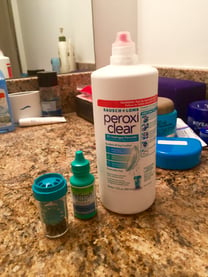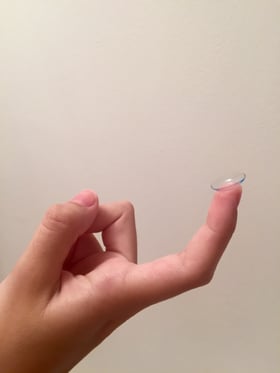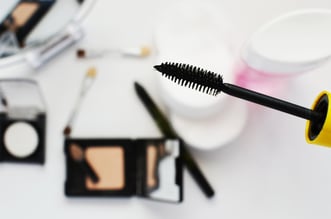Contacts are lifesavers for many people with visual problems who prefer not to use glasses. They’re basically clear “bubble-like” internal lenses that allow you to see better. However, as cool as they are, they come with an instruction manual. Failing to follow it could lead to discomfort, pain, and even irreparable damage to the eye.
To prevent infections and harmful eye conditions, here’s a How-To Guide that will help you understand the Do’s and Dont’s of contact lenses.
1. How to PROPERLY use and care for your lenses
Do:
- Always thoroughly wash your hands with soap and water and dry them with a clean towel before handling contacts.
- Always use the tip of your index finger to insert and remove contacts. Never use your nails - number one cause of lens damage!
- Use cleaning solution recommended by your doctor.
- Be aware that allergic reactions to a contact lens brand or the cleaning solution are possible. Make sure to see your doctor immediately if you experience discomfort or pain.
- Clean your contact case regularly and use fresh solution. You should change your case about every 3 months.
- Moisturize your eyes with saline solution or the right lubricant eye drops if they feel dry.
- Use cleaning solution recommended by your doctor.
- Check your lenses’ recommended wear time - and stick to it
Do NOT:
- Reuse solution, refresh it every day.
- Wear a lens if it’s chipped or broken. It could scratch your cornea or cause other types of damage to your eye. Throw it away!
- Ever wear someone else's contacts, especially if they’ve already been used. You’ll be begging for an infection.
- Over-wear your contacts. It increases risk of eye infections such as viral or fungal keratitis, conjunctivitis and corneal ulcers.
- Sleep in your contacts unless you doctor approves it. It’s always safer to take them out at night, regardless of what the box might say.
- Rinse or store your contacts in water.
- Put your lenses in your mouth to wet them (amazing we have to include this one!).
- Use saline solution and eye lubricants to disinfect lenses. Saline solution can be used to rinse lenses before inserting them, but not for cleaning the lens.

2. When to wear (or not wear) contact lenses
One of the perks of wearing clear contact lenses is that they’re not really visible to others. With the right pair, sometimes you even forget that you’re wearing them. However, even if they’re totally comfortable, there are a few things doctors recommend not to do to prevent infections, irritation and damage.
- Swimming: As you may know by now, contact with water is not recommended for contact lenses. This includes tap water, water in showers, hot tubs, swimming pools, lakes, and oceans. Wearing contacts in water could result in infections, irritation, and potentially sight-threatening conditions. It also increases the chances of the lenses coming out of your eye and getting lost in a large body of water!
- Wearing makeup: The number one rule here is to put in your contacts before you start doing your
makeup, and then taking them out before removing it. This way you can avoid getting it on your lenses, which could cause discomfort and even an infection. Waterproof makeup is not recommended because it makes it difficult to remove makeup without cleaners that are abrasive to the lens. Eyeliner above the lower lash line, eyelash thickeners, and fake eyelashes are also not the best ideas.
Pro tip: use cream eye shadow instead of powder to prevent it from getting in eyes.
- Personal care: ALWAYS wash and dry your hands before handling contacts. Use creams and lotions, perfume, hair gel, makeup remover, perfumed deodorant, scented oils or cold cream soaps after putting in your lenses. In the case of sprays or aerosols (i.e. deodorants, hair spray or spray cologne) try also to use them before inserting your lenses, and wait a bit as there may still be spray floating around. You can put your contacts in after using these products, but be sure to keep your eyes tightly closed until the hairspray has settled.
- Cooking: Although some people say that cooking with contacts in could be dangerous, there’s no real proof. You should be fine to cook with contact lenses in, but if you feel any discomfort due to heat or flames, it is best to remove them. Glasses can get foggy while cooking (the struggle is real!) but if they make you feel safer, use them. It’s important to keep in mind to never touch your eyes while cooking, especially if you’re handling hot peppers or onions.

- Sleeping: According to experts, one of the worst things that you can do to your eyes is sleep in your contacts lenses. The cornea gets oxygen from the air, so when you wear contacts the oxygen supply is less because the contacts block some of the air from getting to the cornea. When you sleep, the oxygen supply is even less because your eyelids are closed - now the air has two layers to get through.. Little to no oxygen causes the cornea to swell up, leading to gaps that serve as an entrance for bacteria. If bacteria enters your cornea, several eye infections and even irreparable damage could occur.
In addition to these tips, the most important thing is to check for your recommended wear time, which depends on the type of lenses that you’re prescribed. Most people use soft contact lenses, which fall into one of the following categories:
- Daily disposable contacts: These disposable contacts are the safest and healthiest type of lens when it comes to infection risk. Since they only last for one use, risk of harmful pathogens building up on the lens surface is low. Never sleep with these contacts in and don’t use them for more than a day.
- Daily wear: This type of lenses needs to be removed every night to be disinfected. Proper cleaning is essential since they are more likely to cause infections like keratitis, an inflammation to the cornea. Their lifespan varies depending on the type of lens, but they usually vary from a month, three months or more than a year of use (since they were first opened). Never sleep with these contacts in, nor use them for more than their lifespan.
- Extended wear: These are the only lenses that you’re technically allowed to wear, without taking them off, for several days in a row. Although experts recommend you still take them off and clean them every night to reduce infection risk, they say you should only go up to six days wearing them and then let your eyes rest for at least a day.
3. When should you call your doctor?
Whether you wear contact lenses or glasses, you should always schedule a yearly check-up with your eye doctor to make sure your eyes are healthy. However, you should remove your contact lenses and call your doctor immediately if you have any of these symptoms:
- Pain
- Unusual redness
- Continuous discomfort
- Persistent blurred vision
- Light sensitivity
- Discharge from eye
- Tearing
- Swelling or irritation
- Vision loss
4. Other tips
- Keep a storage case, small bottle of saline and eye drops with you at all times.
Carry a pair of glasses with you in case you have to remove your contacts due to discomfort, pain, or dryness. Or in case you end up taking a swim or a going on an overnight trip. - Using contact lenses may cause sensitivity to sunlight, so get a pair of sunglasses to protect your eyes from UV light even though your contacts may come with UV light protection.
- Never touch the tip of your cleaning solution bottle, nor let it come into contact with any surface.
- Keep your solution bottle tightly closed when not in use.
- Keep your contact case tightly closed, especially when traveling so the solution doesn’t leak.
- Colored lenses (Halloween, anyone?) are safe most of the time, but make sure to always get them from an eye doctor to prevent an infection or damage to your eye.
- If you develop an unusual symptom, remove your contacts and don’t use them until your doctor says says it’s okay.
- Always follow the doctor’s orders when it comes to contact wear!
Sources:
- "How to Avoid Ripping Contacts." CooperVision. N.p., 07 Oct. 2015. Web. 02 Aug. 2016.
- Boyd, Kierstan. "Proper Care of Contact Lenses." American Academy of Ophthalmology. N.p., 01 Mar. 2016. Web. 02 Aug. 2016.
- "Caring for Your Contact Lenses and Your Eyes." WebMD. WebMD, 13 Sept. 2015. Web. 02 Aug. 2016.
- Godman, Heidi. "Great Eye Drops for Dry Eyes." Healthline. N.p., 28 July 2014. Web. 02 Aug. 2016.
- Boyd, Kierstan. "Contact Lens-Related Eye Infections." American Academy of Ophthalmology. N.p., 14 Oct. 2015. Web. 02 Aug. 2016.
- Chan, Amanda L. "What Every Contact Lens Wearer Needs To Know (But Is Afraid To Ask)." The Huffington Post. TheHuffingtonPost.com, 15 May 2015. Web. 02 Aug. 2016.
- "Contact Lens Do's and Dont's." Edmonds Eyecare. N.p., n.d. Web. 02 Aug. 2016.
- Nussbaum, Rachel. "How Bad Is It to Sleep in My Contacts, Really?" Greatist. N.p., 16 Sept. 2015. Web. 02 Aug. 2016.
- Mayo Clinic Staff. "Adult Health." Contact Lenses: What to Know before You Buy. N.p., 22 Oct. 2015. Web. 02 Aug. 2016.
- Caba, Justin. "Disposable vs. Non-Disposable Contact Lenses: Which Land More People in the Hospital?." Medical Daily. N.p., 14 Nov. 2014. Web. 02 Aug. 2016.
- Mayo Clinic Staff. "Keratitis." - Mayo Clinic. N.p., 10 Sept. 2015. Web. 02 Aug. 2016.
- "Contact Lenses Are like Underwear." (n.d.): n. pag. Centers for Disease Control and Prevention. Web. 02 Aug. 2016.


